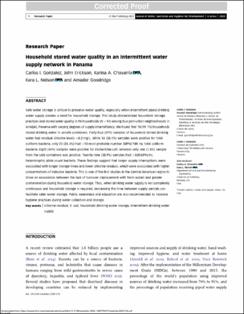| dc.contributor.author | Gonzalez, Carlos I. | |
| dc.contributor.author | Erickson, John | |
| dc.contributor.author | Chavarría, Karina A. | |
| dc.contributor.author | Nelson, Kara L. | |
| dc.contributor.author | Goodridge, Amador | |
| dc.date.accessioned | 2020-05-05T16:53:27Z | |
| dc.date.accessioned | 2020-05-05T16:53:27Z | |
| dc.date.available | 2020-05-05T16:53:27Z | |
| dc.date.available | 2020-05-05T16:53:27Z | |
| dc.date.issued | 2020-04-08 | |
| dc.date.issued | 2020-04-08 | |
| dc.identifier | https://iwaponline.com/washdev/article/doi/10.2166/washdev.2020.156/73558/Household-stored-water-quality-in-an-intermittent | |
| dc.identifier.other | https://doi.org/10.2166/washdev.2020.156 | |
| dc.identifier.uri | https://ridda2.utp.ac.pa/handle/123456789/10303 | |
| dc.identifier.uri | https://ridda2.utp.ac.pa/handle/123456789/10303 | |
| dc.description | Safe water storage is critical to preserve water quality, especially when intermittent piped drinking water supply creates a need for household storage. This study characterized household storage practices and stored water quality in 94 households (N = 94) among four peri-urban neighborhoods in Arraiján, Panama with varying degrees of supply intermittency. We found that 18 (19.1%) households stored drinking water in unsafe containers. Forty-four (47%) samples of household stored drinking water had residual chlorine levels <0.2 mg/L. While 33 (35.1%) samples were positive for total coliform bacteria, only 23 (24.4%) had >10 most probable number (MPN)/100 mL total coliform bacteria. Eight (44%) samples were positive for Escherichia coli, whereas only one (1.3%) sample from the safe containers was positive. Twenty-nine (30.9%) samples had >500 MPN/mL heterotrophic plate count bacteria. These findings suggest that longer supply interruptions were associated with longer storage times and lower chlorine residual, which were associated with higher concentrations of indicator bacteria. This is one of the first studies in the Central-American region to show an association between the lack of turnover (replacement with fresh water) and greater contamination during household water storage. Thus, when drinking water supply is not completely continuous and household storage is required, decreasing the time between supply periods can facilitate safer water storage. Public awareness and education are also recommended to increase hygiene practices during water collection and storage. | en_US |
| dc.description.abstract | Safe water storage is critical to preserve water quality, especially when intermittent piped drinking water supply creates a need for household storage. This study characterized household storage practices and stored water quality in 94 households (N = 94) among four peri-urban neighborhoods in Arraiján, Panama with varying degrees of supply intermittency. We found that 18 (19.1%) households stored drinking water in unsafe containers. Forty-four (47%) samples of household stored drinking water had residual chlorine levels <0.2 mg/L. While 33 (35.1%) samples were positive for total coliform bacteria, only 23 (24.4%) had >10 most probable number (MPN)/100 mL total coliform bacteria. Eight (44%) samples were positive for Escherichia coli, whereas only one (1.3%) sample from the safe containers was positive. Twenty-nine (30.9%) samples had >500 MPN/mL heterotrophic plate count bacteria. These findings suggest that longer supply interruptions were associated with longer storage times and lower chlorine residual, which were associated with higher concentrations of indicator bacteria. This is one of the first studies in the Central-American region to show an association between the lack of turnover (replacement with fresh water) and greater contamination during household water storage. Thus, when drinking water supply is not completely continuous and household storage is required, decreasing the time between supply periods can facilitate safer water storage. Public awareness and education are also recommended to increase hygiene practices during water collection and storage. | en_US |
| dc.format | application/pdf | |
| dc.language | eng | |
| dc.language.iso | eng | en_US |
| dc.publisher | Journal of Water, Sanitation and Hygiene for Development washdev2020156 | en_US |
| dc.publisher | Journal of Water, Sanitation and Hygiene for Development washdev2020156 | |
| dc.rights | https://creativecommons.org/licenses/by-nc-sa/4.0/ | en_US |
| dc.rights | info:eu-repo/semantics/openAccess | |
| dc.subject | chlorine residual | en_US |
| dc.subject | E. coli | en_US |
| dc.subject | household drinking water storage | en_US |
| dc.subject | intermittent drinking water supply | en_US |
| dc.subject | chlorine residual | |
| dc.subject | E. coli | |
| dc.subject | household drinking water storage | |
| dc.subject | intermittent drinking water supply | |
| dc.title | Household stored water quality in an intermittent water supply network in Panama | en_US |
| dc.type | info:eu-repo/semantics/article | en_US |
| dc.type | info:eu-repo/semantics/article | |
| dc.type | info:eu-repo/semantics/publishedVersion | |
